Unveiling the Origins of Ophiuchus in Different Cultures
Look up at the nighttime sky, and you’ll find a constellation often overlooked by modern mythology enthusiasts – Ophiuchus. This intriguing figure represents a serpent bearer and is steeped in ancient mythologies from various cultures around the world. From Ancient Greece to China, Native America to Hinduism, and even in Egyptian art, Ophiuchus has left its mark. Join us on a journey through time and space as we explore the rich and diverse origin myths of Ophiuchus in different cultures. Unravel the fascinating tales of healers, serpents, wisdom keepers, and divine figures as we dive into the hidden depths of this often underrated constellation.
Contents
- Ophiuchus in Ancient Greek Mythology
- Ophiuchus in Chinese Mythology
- Ophiuchus in Native American Mythology
- Ophiuchus in Hindu Mythology
- Ophiuchus in Egyptian Mythology
- Conclusion
- Frequently Asked Questions
- References
-
Frequently Asked Questions
- 1. What is the origin of the Ophiuchus constellation in Greek mythology?
- 2. How does Ophiuchus relate to astrology?
- 3. What role does Ophiuchus play in Chinese mythology?
- 4. How is Ophiuchus portrayed in Native American mythology?
- 5. What significance does Ophiuchus hold in Hindu mythology?
- 6. What is the story of the Serpent King in Hindu mythology?
- 7. How does Ophiuchus tie into Egyptian mythology?
- 8. What symbolism does Ophiuchus exhibit in Egyptian art?
- 9. Why is Ophiuchus not widely recognized in astrology?
- 10. How does Ophiuchus challenge the traditional zodiac system?
- References
- Read More
Ophiuchus in Ancient Greek Mythology
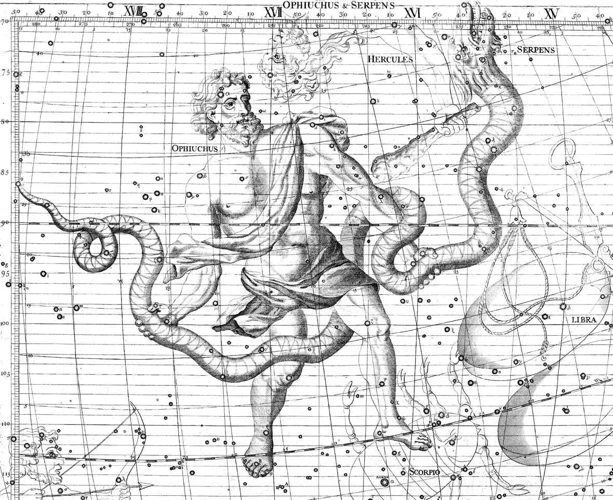
The Legend of Ophiuchus in Ancient Greek Mythology
In Ancient Greek mythology, Ophiuchus is closely associated with the legendary figure of Asclepius. Asclepius was a skilled healer, renowned for his ability to resurrect the dead. According to the myth, Asclepius’s healing abilities became a threat to Hades, the god of the underworld, as his power interfered with the natural order of life and death. In his jealousy, Hades complained to Zeus, the king of the gods, who ultimately decided to punish Asclepius. Zeus struck Asclepius down with a bolt of lightning, ending his mortal life. However, Zeus eventually placed Asclepius in the heavens as the constellation Ophiuchus, honoring his extraordinary healing skills. Ophiuchus is often depicted as a man holding a serpent, symbolizing Asclepius’s connection to healing and wisdom. This intricate mythology showcases the significant role that Ophiuchus played in Ancient Greek culture, representing the power of healing and the delicate balance between life and death. To explore astrology further, you can learn about a birth chart and understand the influence of celestial bodies on an individual’s personality and destiny.
The Legend of Asclepius
The Legend of Asclepius
Asclepius, the central figure in the mythology surrounding Ophiuchus, was born to Apollo, the god of healing and medicine, and the mortal woman Coronis. Raised by the wise centaur Chiron, Asclepius grew up to possess unparalleled knowledge of medicine and became a renowned healer. His healing abilities were so extraordinary that he could even bring the dead back to life. This drew the attention of the gods, who became concerned that Asclepius was disrupting the natural order. Asclepius’s most famous act was his attempt to resurrect Hippolytus, a mortal man who was killed in a chariot accident. In response to Asclepius’s actions, Zeus, the king of the gods, struck him down with a lightning bolt, bringing an end to his mortal life. Despite this, Asclepius was immortalized as the constellation Ophiuchus, forever remembered for his healing prowess and connection to serpents, which were symbols of healing and renewal. The legend of Asclepius offers us a glimpse into the intricacies of Greek mythology and the importance placed on the power of healing. For those interested in exploring different myths and cultural practices, learning about Aztec rituals and sacrifices can provide insight into the purpose and significance of these ancient practices.
Ophiuchus in Astrology
Ophiuchus in Astrology
In the realm of astrology, Ophiuchus occupies a unique position. While traditionally the zodiac consists of twelve signs, Ophiuchus emerges as an additional constellation, positioned between Scorpio and Sagittarius. This celestial serpent bearer represents the qualities of wisdom, healing, and transformation. Ophiuchus individuals are believed to possess an innate ability to heal others and seek knowledge beyond conventional boundaries. They strive for spiritual enlightenment and are often seen as seekers of truth. Despite its recognition in astrology, Ophiuchus is not considered a conventional zodiac sign, and many horoscopes do not account for its influence. However, for those who embrace Ophiuchus’s presence, it adds an intriguing layer of complexity to their astrological identity. If you’re curious about exploring zodiac sign compatibility, you can refer to a zodiac signs compatibility guide to gain insights into how different signs interact and relate to one another.
Ophiuchus in Chinese Mythology
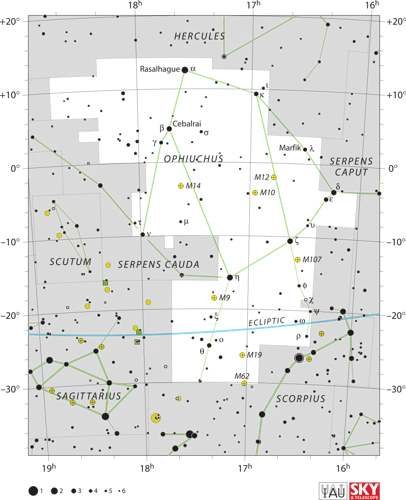
The Serpent Bearer and the Great Flood in Chinese Mythology
In Chinese mythology, Ophiuchus is known as the Serpent Bearer and has ties to the great flood. According to one ancient legend, there once lived a virtuous man named Nuwa, who possessed the body of a serpent but the head of a human. Nuwa was not only a skilled healer but also the creator of mankind. When a catastrophic flood threatened to submerge the earth, Nuwa used her divine powers to mend the sky and strengthen the walls that held back the waters. As the flood subsided, Nuwa placed Ophiuchus in the heavens as a constellation, honoring the role of the Serpent Bearer in the salvation of humanity. This myth symbolizes the power of healing and restoration, and the significant role that Ophiuchus plays in Chinese mythology as a guardian figure. Another intriguing tale from Chinese mythology involves the heavenly emperor’s transformation into Ophiuchus. To delve into more mythical realms, you can explore the purpose and significance of Aztec rituals and sacrifices in ancient Mesoamerican cultures.
The Serpent Bearer and the Great Flood
The Serpent Bearer and the Great Flood
In Chinese mythology, Ophiuchus is associated with a tale known as “The Serpent Bearer and the Great Flood.” According to ancient legends, the world was once plagued by a catastrophic flood. The heavens intervened by sending a divine figure known as the “Heavenly Emperor” to save humanity. The Heavenly Emperor, along with his loyal servant, the Serpent Bearer, embarked on a mission to hold back the floodwaters and protect the people. The Serpent Bearer possessed immense strength and wisdom, wielding the power to control serpents and communicate with them. With the aid of his serpentine allies, he assisted in creating vast channels and redirecting the floodwaters, ensuring the survival of mankind. This captivating narrative emphasizes the significance of Ophiuchus as a symbol of protection, resilience, and the ability to harness the forces of nature. It reveals the integral role that Ophiuchus plays in Chinese mythology and highlights the close relationship between humans, serpents, and the balance of natural elements in ancient Chinese culture.
The Heavenly Emperor’s Transformation
The Heavenly Emperor’s Transformation
In Chinese mythology, the constellation Ophiuchus is associated with a fascinating tale featuring the Heavenly Emperor. According to the legend, there was a time when floods ravaged the earth, bringing chaos and destruction. The Heavenly Emperor, concerned for the well-being of the mortal realm, decided to take action. He transformed himself into the figure of a mighty serpent bearer, represented by the constellation Ophiuchus. As Ophiuchus, the Heavenly Emperor bravely traveled across the land, using his powers to control the flooding and restore balance to the world. This transformation signifies the Heavenly Emperor’s profound connection to the earth and his willingness to protect and preserve the harmony of the natural order. The story of the Heavenly Emperor’s transformation showcases Ophiuchus as a symbol of strength, resilience, and the power to bring order from chaos.
Ophiuchus in Native American Mythology
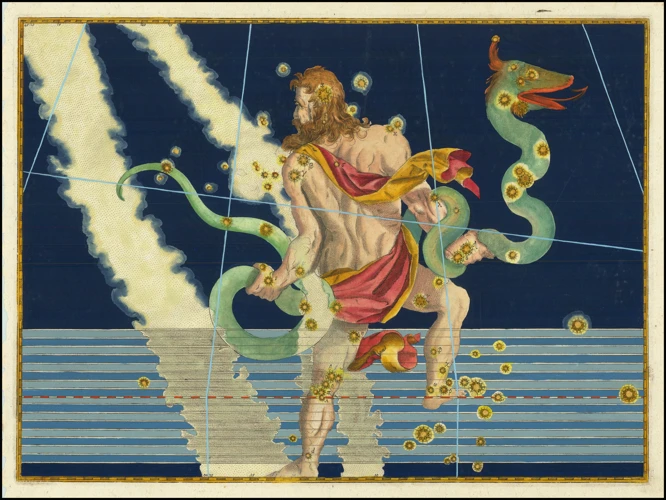
Ophiuchus in Native American Mythology
Native American mythology also holds captivating tales surrounding Ophiuchus, portraying it as a sacred figure revered for its healing abilities and wisdom. In certain tribes, Ophiuchus is seen as a powerful spiritual leader, a guardian of knowledge, and a healer of both physical and spiritual ailments. The connection between Ophiuchus and serpents is prominent in Native American mythology, where serpents are regarded as symbols of transformation, rebirth, and healing energy. The Lakota Sioux tribe, for example, reveres the serpent as a symbol of the divine and acknowledges Ophiuchus as a wisdom keeper who imparts spiritual guidance to the tribe. Ophiuchus’s role as a healer and wisdom keeper exemplifies the deep respect and significance that Native American cultures attribute to this celestial constellation.
Ophiuchus as a Healer and Wisdom Keeper
Ophiuchus as a Healer and Wisdom Keeper
In Native American mythology, Ophiuchus is revered as a symbol of healing and wisdom. Different tribes have varying interpretations of Ophiuchus, but the overarching theme is its association with healing practices and the acquisition of knowledge. Some tribes view Ophiuchus as a spiritual guide who bestows healing powers upon individuals. They believe that those born under the influence of Ophiuchus possess exceptional healing abilities and can tap into ancient wisdom. This constellation is seen as a protector and teacher, guiding individuals on the path to spiritual and physical well-being. Others consider Ophiuchus as a representation of a divine figure who brings balance and harmony to the world. To Native Americans, the connection between Ophiuchus and healing is evident in the use of serpents in their healing rituals. Snakes are symbolic of transformation and rebirth, and their shedding of skin signifies renewal and healing. The wisdom of Ophiuchus lies in understanding the interconnectedness of all living beings and the ability to harness the healing powers of nature. The ancient knowledge associated with Ophiuchus is passed down through generations, ensuring the preservation of healing practices and spiritual wisdom.
The Connection between Ophiuchus and Serpents
The Connection between Ophiuchus and Serpents
One fascinating aspect of Ophiuchus is its strong connection to serpents in various mythologies. In Greek mythology, the serpent is a symbol of healing and rebirth, which aligns perfectly with Ophiuchus’s association with Asclepius, the god of medicine. It is said that Asclepius learned the art of healing from a serpent, which became a representation of wisdom and transformation. This connection is further emphasized by the depiction of Ophiuchus as a serpent bearer, holding a serpent in his hands. The serpent represents the dual nature of life, embodying both poison and antidote, death and rebirth. This symbolism is not limited to Greek mythology; it can also be found in other cultures. In Native American mythology, serpents are often revered as wise beings and medicine guardians. The Aztecs, too, regarded serpents as symbols of transformation and divine wisdom. Exploring the connection between Ophiuchus and serpents highlights the universal significance of these creatures in mythologies across different cultures.
Ophiuchus in Hindu Mythology
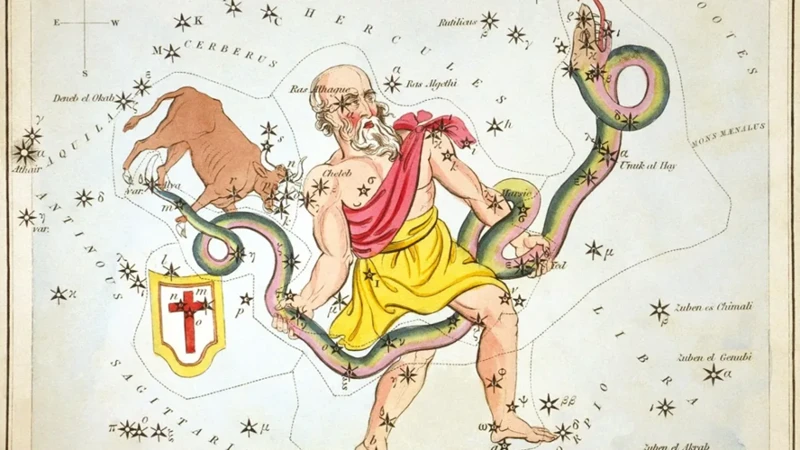
Ophiuchus in Hindu Mythology
In Hindu mythology, Ophiuchus holds a significant place as the Naga, the divine serpent or snake-like creatures associated with water and fertility. Ophiuchus is believed to represent the god Shesha, who supports and carries the world on its back. According to Hindu mythology, during the churning of the cosmic ocean, an elixir of immortality emerged. The gods and demons coveted this elixir, leading to a fierce battle. Lord Vishnu transformed into the enchanting Mohini, capturing the attention of both gods and demons. While the gods drank the elixir, the demons were fooled into thinking that Mohini would distribute it later. During this time, a demon named Rahu disguised himself as a god to try and drink the elixir. However, the sun god Surya and the moon god Chandra noticed the imposter and alerted Lord Vishnu. Vishnu, in his form as Mohini, swiftly cut off Rahu’s head before he could consume the elixir. However, as Rahu’s head had already touched the elixir, he became immortal. The severed head became the planet Rahu, and the body transformed into the constellation Ophiuchus, forever reminding humanity of the consequences of deception and the importance of discernment. Hindu mythology also tells the story of the Serpent King Vasuki, who played a pivotal role in the churning of the cosmic ocean. Vasuki coiled himself around Mount Mandara, acting as a rope to churn the ocean and obtain valuable treasures. Ophiuchus, with its serpent-like figure, symbolizes the intertwined relationship between serpents and divinity in Hindu mythology. The tales of the Naga and the cosmic battles serve to emphasize the significance of Ophiuchus in Hindu culture, perpetuating the idea that serpents possess divine qualities and should be revered.
Ophiuchus and the Naga Serpents
Ophiuchus and the Naga Serpents
In Hindu mythology, Ophiuchus is closely associated with the Naga serpents, who are revered as powerful and wise beings. According to the legends, the Naga serpents are considered the protectors and guardians of sacred knowledge and treasures. Ophiuchus, also known as Asclepius in Greek mythology, is believed to have acquired great wisdom and healing powers from these mystical creatures. The Naga serpents are often depicted as multi-headed and multi-colored, symbolizing their immense power and profound connection to the divine. These serpents are associated with life force, transformation, and spiritual enlightenment. In Hindu iconography, Ophiuchus is sometimes portrayed in cosmic dance with the Naga serpents, signifying the harmony and balance between human and divine energies. The Naga serpents and Ophiuchus represent the deep intertwining of spirituality and healing in Hindu mythology, emphasizing the importance of wisdom and transformation in one’s journey towards enlightenment.
The Story of the Serpent King
Legend has it that in Ancient Greece, there was a powerful and wise king known as Cecrops. He was no ordinary king, as his lower half was that of a serpent. This unique feature earned him the title of the Serpent King. According to the myth, Cecrops was chosen to settle a dispute between Athena, the goddess of wisdom, and Poseidon, the god of the sea. They both desired to be the patron deity of Athens, and Cecrops was tasked with deciding the winner. To impress Cecrops, Poseidon struck his trident on the ground, causing a spring of saltwater to emerge. In response, Athena touched the ground with her spear, revealing an olive tree. Impressed by the practicality and symbolism of the olive tree, Cecrops chose Athena as the patron deity of Athens. This decision greatly angered Poseidon, who cursed Athens with a drought to express his dissatisfaction. The curse remained until Cecrops agreed to build a temple for Poseidon. This myth highlights the significance of the Serpent King in shaping the destiny and identity of Athens, as well as the power of wisdom and practicality represented by Athena.
Ophiuchus in Egyptian Mythology
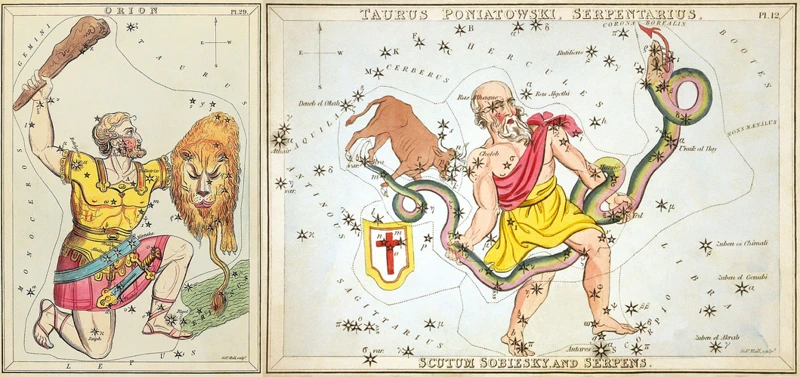
Ophiuchus in Egyptian Mythology
In Egyptian mythology, Ophiuchus holds a significant place, closely associated with the figure of Imhotep, the divine healer. Imhotep was a renowned physician in Ancient Egypt, often considered the earliest known physician in history. He was revered for his knowledge of medicine and his ability to treat illnesses. Imhotep’s reputation grew to such heights that he eventually became deified, with temples dedicated to his worship. Ophiuchus, known as the “serpent bearer,” is often identified as Imhotep in Egyptian art and hieroglyphs. It is believed that Imhotep’s association with the constellation represents his divine healing abilities and his connection to serpents, which were considered symbols of healing and protection in Egyptian culture. Ophiuchus is depicted in Egyptian art as a man holding a serpent or surrounded by serpents, symbolizing Imhotep’s power to cure and provide wisdom. Imhotep’s divine status and Ophiuchus’s symbolism in Egyptian mythology highlight the importance placed on healing and the reverence for those who possessed such skills.
Ophiuchus and Imhotep, the Divine Healer
Ophiuchus and Imhotep, the Divine Healer
In Egyptian mythology, Ophiuchus is closely associated with Imhotep, the legendary figure known as the divine healer. Imhotep was a prominent physician, architect, and advisor to Pharaoh Djoser during the Third Dynasty of Egypt. He was revered for his healing abilities and was eventually deified as a god of medicine. Ophiuchus is believed to represent the amalgamation of Imhotep’s healing prowess and his divine status. The constellation is often depicted as a man holding a staff, closely resembling Imhotep’s image as a healer. Imhotep’s connection with Ophiuchus highlights the importance of healing and medicine in ancient Egyptian culture, as well as the belief in divine intervention for physical and spiritual well-being. The symbolism and association between Ophiuchus and Imhotep showcase the deep-rooted reverence for healers and the value placed on their contributions to society in ancient Egypt. Explore the symbolic significance of various mythological figures and their roles in different cultures. To delve into another intriguing mythological topic, you can learn about the Aztec rituals and sacrifices and gain insight into their purpose and significance in Aztec culture.
The Symbolism of Ophiuchus in Egyptian Art
The Symbolism of Ophiuchus in Egyptian Art
In Egyptian art, Ophiuchus holds a significant place and carries profound symbolism. This constellation is often associated with Imhotep, the divine healer and a prominent historical figure in ancient Egypt. Imhotep was a revered physician, architect, and advisor to Pharaoh Djoser during the Third Dynasty. As a symbol of healing, Ophiuchus is closely tied to Imhotep’s attributes and revered status. Imhotep was believed to possess extraordinary healing powers, and temples dedicated to him became centers of medical practice and education. In Egyptian art, Ophiuchus is depicted as a figure with the head of a snake, representing the association between healing and serpents in Egyptian mythology. This dual representation symbolized the transformative power of healing and the connection between humans and the divine. Ophiuchus’s presence in Egyptian art served as a reminder of the importance of healing and the divine intervention required to restore balance and harmony. Ophiuchus’s symbolism in Egyptian art unveils the profound reverence and admiration ancient Egyptians held for healers and the significant role they played in society.
Conclusion

In Conclusion
The origin myth of Ophiuchus in various cultures showcases the universal fascination with serpents, healers, and wisdom. From Ancient Greek mythology, where Ophiuchus represents the legendary healer Asclepius, to Chinese mythology, where it is associated with the Great Flood and the Heavenly Emperor, and Native American mythology, where it symbolizes the connection between healing and serpents, Ophiuchus has captivated the imaginations of people across different civilizations. Hindu mythology intertwines Ophiuchus with the Naga serpents and tells stories of the Serpent King. Egyptian mythology connects Ophiuchus with Imhotep, the divine healer, and highlights its symbolism in Egyptian art. Despite its lesser-known status in modern astrology, Ophiuchus continues to hold profound significance in the mythologies and beliefs of cultures throughout history. The stories and symbolism surrounding Ophiuchus remind us of the power of healing, wisdom, and the eternal struggle between life and death that transcends boundaries and resonates across time and space.
Frequently Asked Questions

FAQs About Ophiuchus in Ancient Greek Mythology
1. What does Ophiuchus represent in Ancient Greek mythology?
Ophiuchus represents the legendary healer, Asclepius, known for his ability to resurrect the dead.
2. Why was Asclepius transformed into Ophiuchus?
Asclepius’ healing abilities threatened the natural order of life and death, leading to Zeus transforming him into the constellation Ophiuchus.
3. How is Ophiuchus depicted in Ancient Greek mythology?
Ophiuchus is often represented as a man holding a serpent, symbolizing the healing and wisdom associated with Asclepius.
4. What role did Ophiuchus play in Ancient Greek culture?
Ophiuchus symbolized the power of healing and the delicate balance between life and death. Asclepius was highly revered and worshipped as a healing deity.
5. Was Ophiuchus a part of the original Greek zodiac?
No, Ophiuchus was not originally included in the Greek zodiac but was later recognized as a constellation due to its mythological significance.
6. Are there any temples or sacred sites dedicated to Asclepius in Ancient Greece?
Yes, one of the most famous temples dedicated to Asclepius was the Sanctuary of Asclepius at Epidaurus, where people sought healing through various rituals and offerings.
7. Did Ophiuchus have any siblings or notable family members?
Yes, Ophiuchus was the son of Apollo, the god of music, healing, and light, and Coronis, a mortal woman.
8. Were there any famous healers or physicians who claimed descent from Asclepius?
Yes, the most famous group of healers known as the Asclepiads claimed direct descent from Asclepius and were highly respected for their medical expertise throughout Ancient Greece.
9. Did Ophiuchus have any other significant associations or myths besides Asclepius?
In addition to Asclepius, Ophiuchus is sometimes connected to the story of the Titan Prometheus, who was also skilled in healing arts and regarded as a savior figure for humanity.
10. Why is Ophiuchus often overlooked or excluded when discussing Greek mythology?
Ophiuchus may be overlooked in discussions of Greek mythology because it was not part of the original zodiac and is less widely known compared to other prominent constellations and figures.
References
Frequently Asked Questions

1. What is the origin of the Ophiuchus constellation in Greek mythology?
The Ophiuchus constellation is believed to represent the legendary healer and demigod, Asclepius. He was a skilled physician and the son of Apollo, the Greek god of medicine and healing.
2. How does Ophiuchus relate to astrology?
In astrology, Ophiuchus is often regarded as the 13th zodiac sign, although it is not officially recognized by all astrologers. It is associated with attributes such as healing, transformation, and wisdom.
3. What role does Ophiuchus play in Chinese mythology?
In Chinese mythology, Ophiuchus is associated with the story of the Serpent Bearer and the Great Flood. It is also linked to the transformation of the Heavenly Emperor into a serpent-like creature.
4. How is Ophiuchus portrayed in Native American mythology?
In Native American mythology, Ophiuchus is often depicted as a wise healer and guardian of wisdom. It is believed to possess the power to connect with the spiritual realm and bestow healing abilities upon individuals.
5. What significance does Ophiuchus hold in Hindu mythology?
Ophiuchus holds significance in Hindu mythology due to its association with the Naga serpents, who are considered both divine protectors and sources of wisdom. Ophiuchus is believed to have a special bond with these serpents.
6. What is the story of the Serpent King in Hindu mythology?
The story of the Serpent King revolves around Vasuki, the king of the Nagas, who desires immortality. Ophiuchus plays a role in the legend as it is said to hold the key to unlocking the secret of immortality.
7. How does Ophiuchus tie into Egyptian mythology?
Ophiuchus is linked to Egyptian mythology through Imhotep, the divine healer and advisor to the pharaohs. Imhotep, often associated with the Ophiuchus constellation, was revered as a powerful deity and patron of medicine.
8. What symbolism does Ophiuchus exhibit in Egyptian art?
In Egyptian art, Ophiuchus symbolizes healing, protection, and divine knowledge. It is often depicted holding serpents, representing its connection to the wisdom and transformation associated with serpents.
9. Why is Ophiuchus not widely recognized in astrology?
Ophiuchus is not widely recognized in astrology because the traditional zodiac system consists of 12 signs. However, some astrologers and enthusiasts have begun to incorporate Ophiuchus as a 13th sign in their interpretations.
10. How does Ophiuchus challenge the traditional zodiac system?
Ophiuchus challenges the traditional zodiac system by introducing a new sign and altering the dates associated with each sign. This has sparked debates and discussions among astrologers and astrology enthusiasts.







